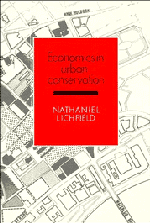Book contents
- Frontmatter
- Contents
- List of diagrams, tables and plans
- Preface
- Acknowledgements
- Introduction
- Part I Planning and management in the conservation of the urban system
- Part II Conservation of the cultural built heritage
- Part III Economics in urban conservation
- Part IV Selected tools of economic analysis for project evaluation
- Part V Case studies in the economics of conservation of the CBH
- 16 The case studies
- Notes
- Bibliography
- Index
16 - The case studies
Published online by Cambridge University Press: 10 November 2010
- Frontmatter
- Contents
- List of diagrams, tables and plans
- Preface
- Acknowledgements
- Introduction
- Part I Planning and management in the conservation of the urban system
- Part II Conservation of the cultural built heritage
- Part III Economics in urban conservation
- Part IV Selected tools of economic analysis for project evaluation
- Part V Case studies in the economics of conservation of the CBH
- 16 The case studies
- Notes
- Bibliography
- Index
Summary
Case study 1: viability for occupation
The case
Central Buildings, Southwark, London, was built around the middle of the nineteenth century, in twelve storeys including a double basement. It was originally used as a hop auction market, containing for the purpose a domed balconied well from ground floor to the roof, rising 115 ft. through the full ten floors above ground. Around 1920 it suffered severe damage by fire, and in World War II from bombing. As a result of the demolition following the fire and the bombing there were only between four and six floors left, including the double basement. As a result it had lost much of its original architectural quality.
The issue
Around 1970 the owners were faced with a problematic building. There was no longer any call for the original use; the fire, bombing and subsequent adaptation had resulted in a large central gallery with small suites of offices situated around its remnants; the cellars were of little use in contemporary conditions; maintenance costs were high, because of age, fire, wartime bombing and running sand and water 12 ft. below pavement level.
As a result the owners were considering redevelopment. But in March 1970 the building was spot-listed as Grade II, with particular reference to its facade, internal galleried court and ironwork. This reinforced the powers of control against redevelopment already afforded by the inclusion of the building in a conservation area. Redevelopment was accordingly resisted by the authorities.
- Type
- Chapter
- Information
- Economics in Urban Conservation , pp. 289 - 316Publisher: Cambridge University PressPrint publication year: 1989



